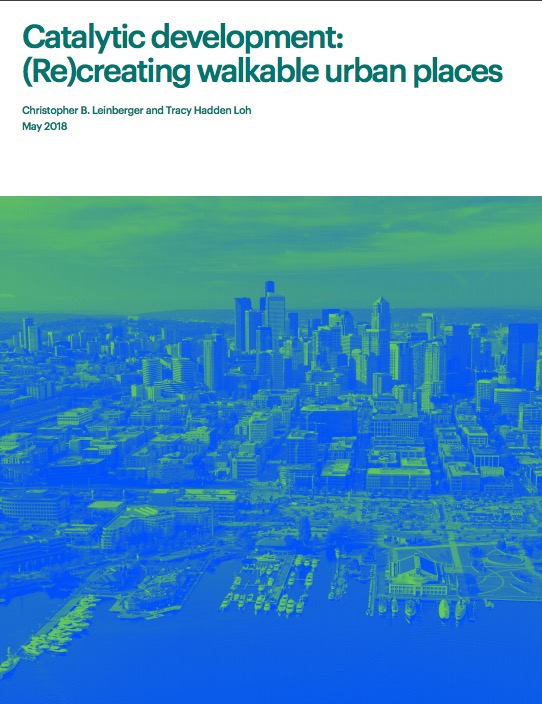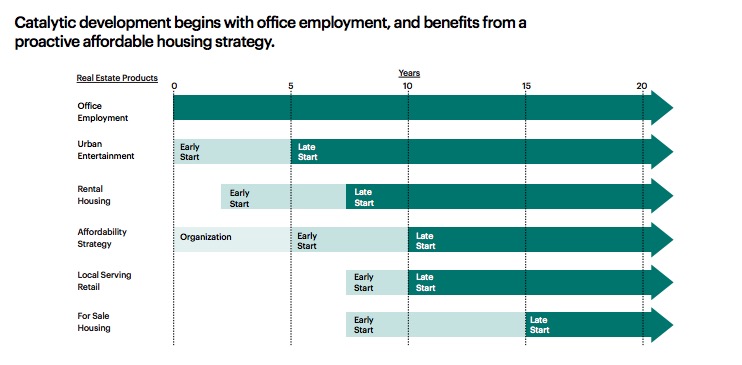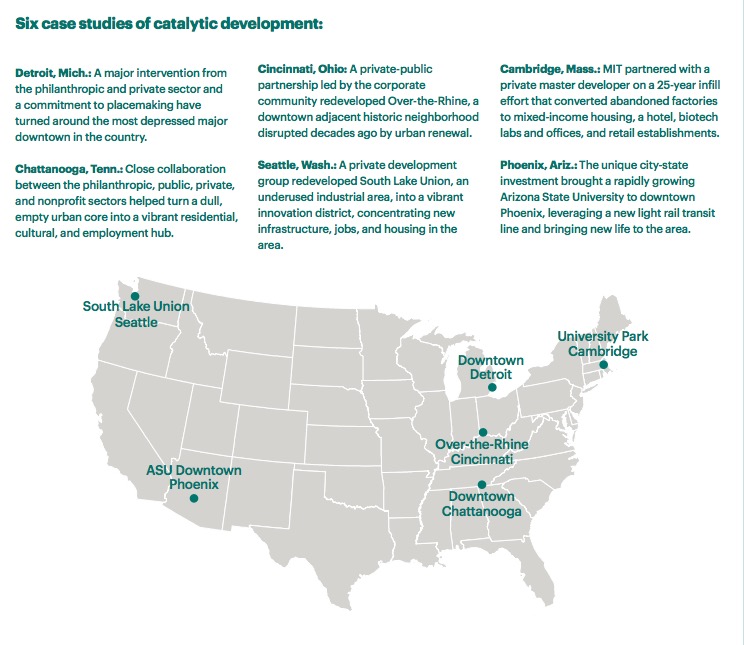METROPOLITAN POLICY PROGRAM AT BROOKINGS
By Christopher B. Leinberger and Tracy Hadden Loh
Executive Summary
 Since the mid-1990s, demographic and economic shifts have fundamentally changed markets and locations for real estate development. These changes are largely powered by growth of the knowledge economy, which, since the turn of the 21st century, has begun moving out of suburban office parks and into more walkable mixed-use places in an effort to attract and retain highly educated young workers and support creative collaboration among them.
Since the mid-1990s, demographic and economic shifts have fundamentally changed markets and locations for real estate development. These changes are largely powered by growth of the knowledge economy, which, since the turn of the 21st century, has begun moving out of suburban office parks and into more walkable mixed-use places in an effort to attract and retain highly educated young workers and support creative collaboration among them.
This paper takes an in-depth look at six case studies to describe the process of catalytic development, a new model of investment that over the past decade has had remarkable success in creating such walkable communities. Catalytic development focuses on areas abandoned as a result of deindustrialization and auto-oriented development, in some cases recycling the very properties cleared or left vacant by mid-20th century urban “renewal” programs. Catalytic development incorporates many urban design best practices—granularity, incrementalism, and mixing of uses, scales, and people—and can address difficult urban challenges while delivering long-term economic returns to both the public and private sectors.
The catalytic development model
Walkable urban development has historically been the dominant approach to city-building. This changed in the early to mid-20th century, when drivable suburbs emerged as a new form of development made possible by the introduction of low-cost automobile transport, and then supported by market preferences, government subsidies, zoning regulations, and a financing formula that became well-understood and accepted in cities throughout the world.
Catalytic development represents a counterweight to these forces—a place-based response to changing demands that facilitates large-scale investment in concentrated, walkable urban areas. It has three defining features that set it apart from traditional real estate development:
- Patient equity—Financial equity that has expectations of returns over the long term, generally beyond year five of the investment and longer.
- Integrated development—The assemblage of and investment in proximate land parcels that together reshape the area and help spur additional growth, as well as the combining of conventionally separate real estate roles in single companies.
- Employment first—Either substantial employment growth early in the redevelopment process or an existing central employment base with significant entry-level opportunity.
This report highlights six examples where private, university, or non-profit developers have employed the catalytic development model to reinvigorate walkable urban communities.
These case studies reveal important lessons for real estate developers, investors, anchor institutions, corporations, philanthropists, local government leaders and staff, and urbanists seeking to create economically productive and socially inclusive walkable urban places in their own cities, including:
- All of the case studies identified some kind of crisis as the context for catalytic development. In the most extreme cases, the downtown or other potential walkable urban place had hit rock bottom from a market perspective, but had economic, physical, cultural, or other assets on which to build.
- Catalytic development tends to be led by a proven leader who brings credibility from a combination of vision, track record, and access to patient capital. But developers must find a balance between their need for agility and control, and the need to engage the broader community in an inclusive process that builds trust and achieves equitable outcomes.
- Even when guided by a master plan, catalytic developments are multi-phase endeavors that come together one building at a time, adapting and responding to unexpected opportunities and challenges as they arise. Catalytic developers set the stage for their own long-term success with a flexible, incremental strategy, rather than a megaproject. Strong place management is vital to this process.
- Catalytic developers have a commitment to quality development, though achieving it can be difficult. Across the board, the case study participants emphasized a desire to “go above and beyond what the code requires,” develop “great open space … maintained very, very well,” and “design great buildings that are dictated not just by cost per square foot but also the long term aspirations for the institution and community.”
- A diversity of ideas, efforts, and shared risk is essential to the sustained growth of a catalytic development, demanding that developers actively encourage the ongoing engagement of other stakeholders in the community.
Catalytic development is not available or appropriate for all redevelopment situations. However, the explosion of private wealth of the last generation—one driver of income inequity—can also be used to turn brownfields, failing business parks, and center city and suburban town centers into thriving and vital walkable urban places. Catalytic development is not only about fostering rapid economic growth, but if done right, has the potential to create socially equitable, environmentally sustainable, and healthier places to live and work.
Download full version (PDF): Catalytic development
About the Metropolitan Policy Program at Brookings
www.brookings.edu/program/metropolitan-policy-program
The Metropolitan Policy Program at Brookings delivers research and solutions to help metropolitan leaders build an advanced economy that works for all.
Tags: Brookings Institution, catalytic development, development, Metropolitan Policy Program at Brookings








 RSS Feed
RSS Feed